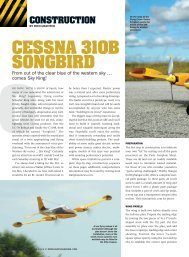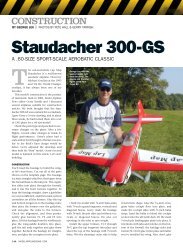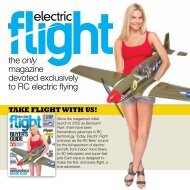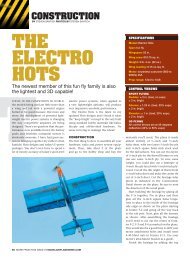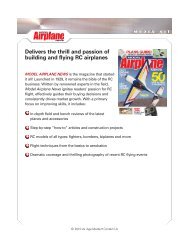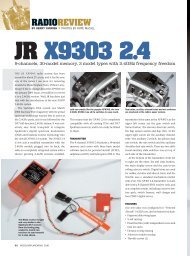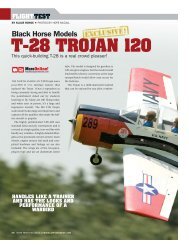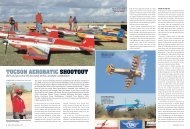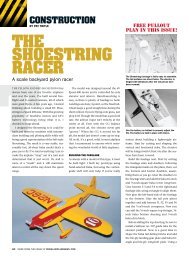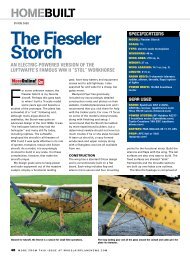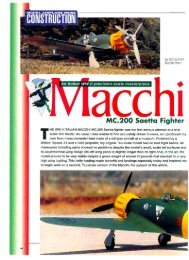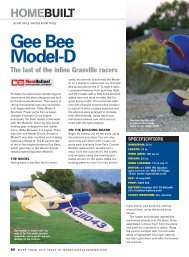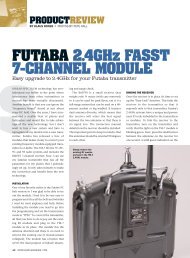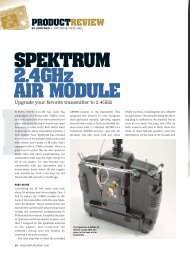Create successful ePaper yourself
Turn your PDF publications into a flip-book with our unique Google optimized e-Paper software.
percent of MAC aft of the upper-wing<br />
leading edge? Thank you for your help.<br />
Great article!<br />
BILL TRUEBLOOD<br />
Edgewater, MD<br />
Bill; thank you for your feedback. It is true that<br />
the bigger wing will generate a larger portion of<br />
the lift than the smaller wing, even with the<br />
slight difference in incidence. In practice, the<br />
model will behave normally. Use the horizontal<br />
distance from the top wing leading edge to the<br />
bottom wing trailing edge as the MAC line, then<br />
use the 25 percent point location for the balance<br />
point. This will be a safe place to start. Also,<br />
check where the plan designer indicated the CG.<br />
I always start there and adjust accordingly after<br />
I've test-flown the model. Depending on the<br />
model's behavior, you may still have to slightly<br />
adjust its balance point one way or the other.<br />
When you finish your model, send us a picture<br />
for "PilotProjects." GY<br />
GYRO GYRATIONS<br />
I just finished reading Rick Bell's article<br />
about gyros. It was very helpful, as I have<br />
always been curious about them and how<br />
they work. I hope you can answer a question.<br />
In the section, "Uses for gyros," it<br />
states that using a gyro on the elevator and<br />
the rudder can help a modeler learn to<br />
torque roll. If I want to connect a gyro to a<br />
particular axis for the rudder<br />
and another axis for the<br />
elevator, does that mean<br />
I need two gyros?<br />
JEFF COOMBES,<br />
Austin, TX<br />
Jeff; I'm glad that you found the information in<br />
the gyro article useful. I had a lot of fun<br />
researching the article and learned a lot about<br />
gyros along the way. To answer your question: at<br />
the present time, gyros control only one axis at a<br />
time; so, yes, you'll need to use a separate gyro<br />
on each control surface (elevator and rudder).<br />
You can hook up both (with a Y-harness) to a<br />
single auxiliary channel, so you'll be able to timi<br />
them off when you're not using them.<br />
Otherwise, the gyros will be active all the time,<br />
and that will affect your control inputs. Be sure<br />
to thoroughly test the gyro inputs and the gain<br />
featiire before flying. RB<br />
Head Lock (tm) Remote<br />
spring loaded locking Glow<br />
Plug Connector fits under Plane<br />
cowls and Helicopter canopies,<br />
letting you cover the glow plug<br />
and head. #M021 Single<br />
shown.<br />
Remote Jack<br />
allows you to<br />
power your plug(s)<br />
from anywhere on<br />
the model, away<br />
from<br />
the<br />
prop<br />
Head Lock.<br />
Head Lock Remote.<br />
The Original Locking<br />
GlowPlug Connectors.<br />
Extended version<br />
For deep heat sink<br />
heads on cars, helicopters<br />
and boats. (#M056)<br />
Or for direct power: Head Lock<br />
(tin) fits all standard glow plugs,<br />
is powered by 1.2V to 1.5V battery<br />
or Power Panel. (#M009<br />
Shown)<br />
Want to cover your engine? Or keep your hands away from the prop? Use a Head Lock<br />
Remote. They look great, they work great and they're backed by Sullivan quality.<br />
Head Lock Remotes are available in single (M021), Extended (M056) and twin (M022)<br />
configurations. They have a low profile locking head and a<br />
remote jack that can be hidden away from the engine. Head<br />
Locks feature 18 gauge power cords and are available in<br />
Standard (M009) and Professional (stainless steel, M037).<br />
Sullivan. 50 years of setting the standard. Made in the USA.<br />
PRODUCTS<br />
One North Haven Street. Baltimore.<br />
Maryland 21224 USA.<br />
www.sullivanproducts.com<br />
GETTING BETTER IDEAS OFF THE GROUND<br />
COOL IT!<br />
A brief note to express my gratitude for the<br />
very informative article entitled "Cool It"<br />
that appeared in your April 2002 issue.<br />
Thanks to it, many of my longstanding<br />
questions about model engine fuels and<br />
engines were answered—a classic example<br />
of the instructive and understandable<br />
content you provide. Not all of us are<br />
engineers, but we are people who thoroughly<br />
enjoy model airplanes.<br />
ED GILLANDERS<br />
Poulsbo, WA<br />
Thanks for your kind words regarding the<br />
engine-cooling article. It's always a pleasure<br />
to hear from readers who benefited from our<br />
efforts! DAVE GIERKE<br />
JUNE 2002 1 1



